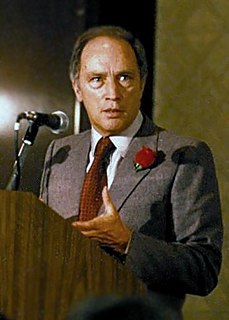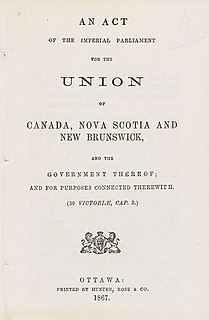
The Constitution of Canada is the supreme law in Canada. It outlines Canada's system of government and the civil and human rights of those who are citizens of Canada and non-citizens in Canada. Its contents are an amalgamation of various codified acts, treaties between the Crown and Indigenous Peoples, uncodified traditions and conventions. Canada is one of the oldest constitutional monarchies in the world.
The British North America Acts 1867–1975 are a series of Acts of Parliament that were at the core of the constitution of Canada. Most were enacted by the Parliament of the United Kingdom and some by the Parliament of Canada. In Canada, some of the Acts were repealed in Canada by the Constitution Act, 1982. The rest were renamed the Constitution Acts and amended, with those changes only having effect in Canada. The Canadian versions of the Constitution Acts make up the Constitution of Canada, and can only be amended in Canada.

The Manitoba Schools Question was a political crisis in the Canadian province of Manitoba that occurred late in the 19th century, attacking publicly-funded separate schools for Roman Catholics and Protestants. The crisis was precipitated by a series of provincial laws passed between 1890 and 1896, and another passed in 1916.
The Constitution Act, 1982 is a part of the Constitution of Canada. The Act was introduced as part of Canada's process of patriating the constitution, introducing several amendments to the British North America Act, 1867, including re-naming it the Constitution Act, 1867. In addition to patriating the Constitution, the Constitution Act, 1982 enacted the Canadian Charter of Rights and Freedoms; guaranteed rights of the Aboriginal peoples of Canada; provided for future constitutional conferences; and set out the procedures for amending the Constitution in the future.
The Constitutional debate of Canada is an ongoing debate covering various political issues regarding the fundamental law of the country. The debate can be traced back to the Royal Proclamation, issued on October 7, 1763, following the signing of the Treaty of Paris (1763) wherein France ceded most of New France to Great Britain in favour of keeping Guadeloupe.
In Canada, a separate school is a type of school that has constitutional status in three provinces and statutory status in the three territories. In these Canadian jurisdictions, a separate school is one operated by a civil authority—a separate school board—with a mandate enshrined in the Canadian Constitution or in federal statutes. In these six jurisdictions a civil electorate, composed of the members of the minority faith, elects separate school trustees according to the province's or territory's local authorities election legislation. These trustees are legally accountable to their electorate and to the provincial or territorial government. No church has a constitutional, legal, or proprietary interest in a separate school.

The Constitution Act, 1867, originally enacted as the British North America Act, 1867, and referred to as the BNA Act or the Act, is a major part of the Constitution of Canada. The Act created a federal dominion and defines much of the operation of the Government of Canada, including its federal structure, the House of Commons, the Senate, the justice system, and the taxation system. The British North America Acts, including this Act, were renamed in 1982 with the patriation of the Constitution ; however, it is still known by its original name in United Kingdom records. Amendments were also made at this time: section 92A was added, giving provinces greater control over non-renewable natural resources.
The constitutional history of Canada begins with the 1763 Treaty of Paris, in which France ceded most of New France to Great Britain. Canada was the colony along the St Lawrence River, part of present-day Ontario and Quebec. Its government underwent many structural changes over the following century. In 1867 Canada became the name of the new federal Dominion extending ultimately from the Atlantic to the Pacific and the Arctic coasts. Canada obtained legislative autonomy from the United Kingdom in 1931, and had its constitution patriated in 1982. Canada's constitution includes the amalgam of constitutional law spanning this history.

The official languages of Canada are English and French, which "have equality of status and equal rights and privileges as to their use in all institutions of the Parliament and Government of Canada," according to Canada's constitution. "Official bilingualism" is the term used in Canada to collectively describe the policies, constitutional provisions, and laws that ensure legal equality of English and French in the Parliament and courts of Canada, protect the linguistic rights of English- and French-speaking minorities in different provinces, and ensure a level of government services in both languages across Canada.

Maher v Town Council of Portland is a Canadian constitutional law court decision dealing with the constitutional guarantees for denominational schools set out in section 93 of the Constitution Act, 1867. The issue was whether the Common Schools Act, enacted by the Province of New Brunswick in 1871, infringed the guarantee of denominational schools set out in section 93(1).
Before 1982, modifying the Constitution of Canada primarily meant amending the British North America Act, 1867. Unlike most other constitutions, however, the Act had no amending formula; instead, changes were enacted through Acts of the Parliament of the United Kingdom called the British North America Acts.
Section 23 of the Canadian Charter of Rights and Freedoms is the section of the Constitution of Canada that guarantees minority language educational rights to French-speaking communities outside Quebec, and, to a lesser extent, English-speaking minorities in Quebec. The section may be particularly notable, in that some scholars believe that section 23 "was the only part of the Charter with which Pierre Trudeau was truly concerned." Trudeau was the prime minister who fought for the inclusion of the Charter of Rights in the Constitution of Canada in 1982.
Section 29 of the Canadian Charter of Rights and Freedoms specifically addresses rights regarding denominational schools and separate schools. Section 29 is not the source of these rights but instead reaffirms the pre-existing special rights belonging to Roman Catholics and Protestants, despite freedom of religion and religious equality under sections 2 and 15 of the Charter. Such rights may include financial support from the provincial governments. In the case Mahe v. Alberta (1990), the Supreme Court of Canada also had to reconcile denominational school rights with minority language educational rights under section 23 of the Charter.

Adler v Ontario (AG), [1996] 3 S.C.R. 609 is a leading decision of the Supreme Court of Canada on the nature of the provincial education power and whether there was a constitutional obligation to fund private denominational education. The Court found that Ontario's Education Act did not violate sections 2(a) or 15(1) of the Canadian Charter of Rights and Freedoms or section 93 of the Constitution Act, 1867.
Because the country contains two major language groups and numerous other linguistic minorities, in Canada official languages policy has always been an important and high-profile area of public policy.
The existence of Catholic schools in Canada can be traced to the year 1620, when the first school was founded Catholic Recollet Order in Quebec. The first school in Alberta was also a Catholic one, at Lac Ste.-Anne in 1842. As a general rule, all schools in Canada were operated under the auspices of one Christian body or another until the 19th century. It is estimated that 60% of Residential Schools were operated by the Catholic Church.
The language policies of Canada's province and territories vary between the provinces and territories of Canada. Although the federal government operates as an officially bilingual institution, providing services in English and French, several provincial governments have also instituted or legislated their own language policies.
Freedom of religion is a constitutionally protected right in Canada, allowing believers the freedom to assemble and worship without limitation or interference, but it was not always so.

Section 93A of the Constitution Act, 1867 is a provision of the Constitution of Canada, extinguishing the right to publicly funded denominational and separate schools in the province of Quebec. It was enacted as a bilateral constitutional amendment in 1997.

Section 17 of the Constitution Act, 1867 is the provision of the Constitution of Canada which created the federal Parliament of Canada. The Parliament is composed of the Queen of Canada; the appointed upper house, the Senate of Canada; and the elected lower house, the House of Commons of Canada. Political power rests mainly with the elected House of Commons.







